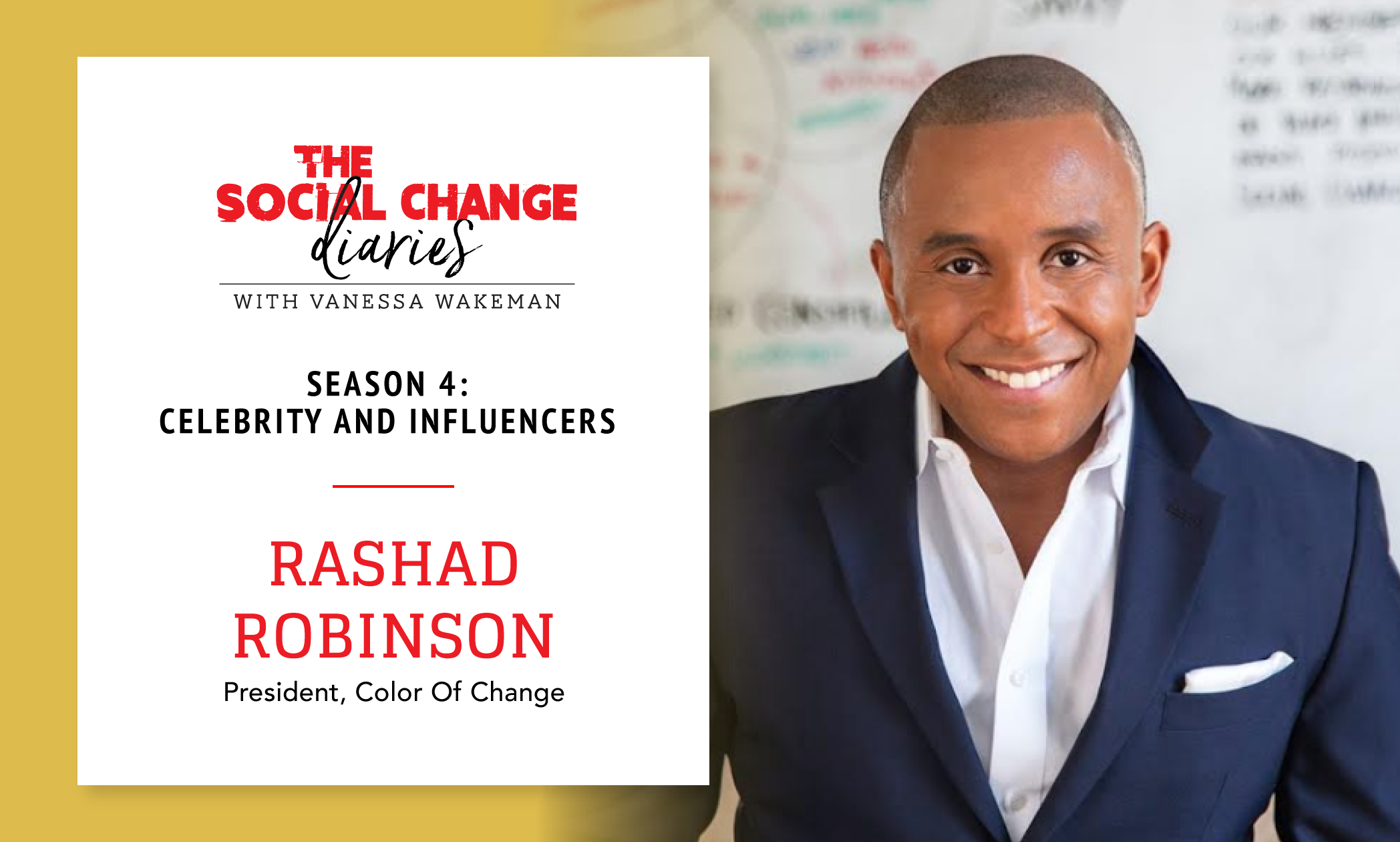

About This Episode
At the helm of Color Of Change, the largest online racial justice organization in the country, Rashad Robinson’s reach and influence is undeniable. In this episode of the Social Change Diaries, he reveals the core structure that makes Color Of Change so powerful. He talks about leading the successful campaign waged against credit companies who accepted money from hate groups- an effort that catalyzed everyday citizens into a powerful group of 1.4 million activists- and what celebrity and influence means from his vantage point.
About Rashad Robinson
Rashad Robinson is the President of Color Of Change, the nation’s largest online racial justice organization. Driven by over one million members, Color Of Change builds power for Black people and Black communities, moving decision makers in corporations and government to create a more human and less hostile world for Black people and all people. Robinson helped Color Of Change lead winning campaigns forcing over 100 corporations to stop funding ALEC, frame and win net neutrality as a major civil rights issue, and force Pat Buchanan and Bill O’Reilly off the air. Successful Color Of Change strategies have been profiled in The New York Times, The Washington Post, Fast Company and The Hollywood Reporter, and on CNN, NPR, PBS and MSNBC. In 2015, Fast Company named Color Of Change the 6th Most Innovative Company in the world, and in 2016, the Stanford Social Innovation Review profiled Color Of Change. Robinson is the proud recipient of awards from organizations as varied as ADCOLOR, the United Church of Christ and the Martin Luther King, Jr. Memorial Foundation. He serves on the boards of Demos and the Hazen Foundation.
In his words…
“I consistently think about subcultures of communities. How are we reaching in and engaging more young people across the black experience. How are we engaging black immigrants, black, rural folks, black urban people, church folks, non-church folks, sorority members, LGBT people. I’m constantly trying to think with our staff about who we are reaching in various ways and how are we helping people navigate the political environment, to make the right decisions for their participation, to help people have the most strategic thing to do when something hits their community, so that they’re not just expressing frustration, but they’re able to make strategic action.”
“Color Of Change really thinks about itself at the intersection of analysis and action. We’re constantly thinking about how do we help people make sense of the world, but most importantly, how do we move people to strategic action?”
“We have a framework at Color Of Change of not mistaking presence for power. Presence is ability, it’s awareness, it’s retweets, it’s people talking about your issue. Power is the ability to change the rules and you only get to power through action. What we have to do is build the type of energy, activism and strategy that forces real change. That for me is why we keep people engaged.”
“Companies want to be on the right side of the bottom line. They want to be on the right side of their shareholders, they want to be on the right side of the press and PR- that’s their incentive structure. As long as we go in knowing that, then we’re not confused. It doesn’t mean there aren’t good people that work inside of companies, but we have to recognize what the incentive structures are and how power actually works. Being clear about that helps us strategically know how to engage them, how to push them, know what they’re going to value and what they’re going to not value.”
“We praise companies for making the right decisions, but anyone who thinks these companies simply made the right decision without pressure, without being forced, then we haven’t learned the right lessons about the type of activism and action that we have to move. We also haven’t learned the right lesson about the incentive structures with a deep recognition that as soon as these companies make the right decision, they could still go back and make the wrong decision the next day. That’s what we have to keep the pressure on, and we have to change the rules in the process, as well.”
“If we’re not focused on changing the rules over time, then we are just continuing to play a perpetual game of whack-a-mole and not having the type of long-term change that communities deserve.”
“We don’t own a 24 hour news station that parrots everything we want to say- we don’t own a network of radio stations that repeats over and over again all throughout the day, our talking points. As a result, celebrities and influencers and those with big platforms have the ability to help us reach a broader audience, help us give people clear things to do.”
“What we’re constantly trying to do through our storytelling and through our work is move people from seeing problems as unfortunate, to seeing them as unjust. And by seeing them as unjust, we’re then able to build a new type of incentive for real long-term change. Not just charity, but justice.”
Questions Answered on this Episode
Color Of Change was created after Hurricane Katrina. Can you share the specific vision/mission for the org at that time and how, if at all, it has changed since that time? Has the work of the organization shifted since Trump took office?
Can you describe your primary audience? Who are the millions of people behind the organization?
Color Of Change has been successful in getting corporations to stop the funding of hate groups, commanded the attention of celebrities for specific campaigns, and getting ordinary citizens to engage on social issues. Why do you think the organization has been so successful in capturing the attention and buy-in from such diverse stakeholder groups?
In recent years, several clients have had to make really difficult decisions about their funding sources. Do they accept money from a racist donor, or a company that isn’t in alignment with the organization’s values, and risk not being able to provide services to their constituents? You and your team are often going into the mouth of the lion to confront organizations about their business practices and influencing their behavior about who they support. Based on your experience, do you think companies are beginning to be more mindful of their practices in a positive way – meaning they want to be on the right side of history or are we not there yet?
As the largest online racial justice organization, you have had tremendous impact on a number of important issues, often being one of the first to bring attention to injustice. How are you able to act so quickly and effectively?
Are there any examples you can share of celebrities or influencers getting behind one of your campaigns and the impact that it has had?
Based on the current political climate, there are a number of competing priorities as it relates to social justice issues. One of the challenges for many of our listeners that are smaller, local organizations is how do they keep their narrative top of mind for their target audiences. Are there any tips that you can share, since your organization does it so masterfully?
One of the many things I appreciate about Color Of Change is its inclusivity. It gives everyone a voice and shifts the paradigm of power. People get to see that they do have the power to influence change. The organization is shifting how people see themselves and that is powerful. What do you see as the potential ripple effect of that?
What would you say is the biggest social issue of our time as it relates to racial injustice and what will be needed to solve it?
